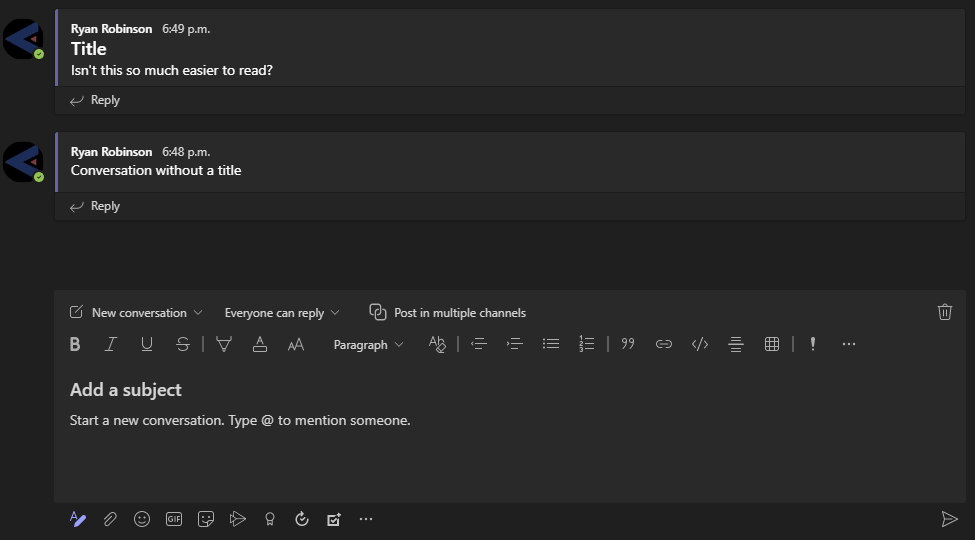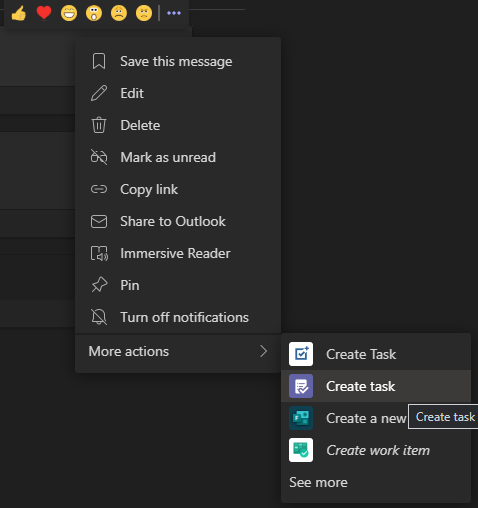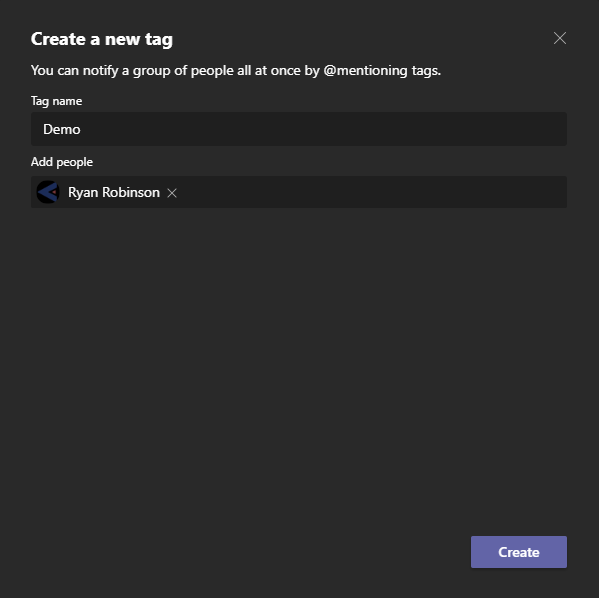tl;dr: Here are some of my favourite less-obvious features in Teams.
Microsoft Teams is a very big program, essentially combining together equivalent functionality to Skype, Slack, Zoom, Google Drive, VOIP phone systems, and a few more all into one… plus the ability to develop your own apps for it. New features keep coming at a rapid pace. That makes it easy to miss some of the helpful little things that Teams offers. I’ll have more posts soon about organization admin settings and policies for Teams, but here are a few of my favourite tricks that most typical users can take advantage of in their own workflows but may not be obvious.
Title on Conversations
Having conversations in the Teams channels is great. It is a useful tool for having quick conversations in a nice threaded interface that stay available for search later. One common problem, though, is that when there’s a bunch of conversations, it is hard to find your way back to the one that you’re looking for.
One feature that really helps with this: add a title to the conversation. By default when you try to start a new conversation, you only get a little text book to enter the content. But there’s more you can do. One of those in the bottom left is a little format icon. Click on that and you’ll see a few options including bold, italics, underline, quote, code, and alignment. My favourite, though, is that it adds a place to add a title for the post. This makes it a lot easier when you’re scrolling through old conversations to see a summary of what that conversation is about, in larger font.

Tasks
This one is slightly less hidden. It might even be more obvious in the sidebar in your organization. But for me, when it became available, it was tucked away where it wasn’t obvious. If you use one of Planner or To-Do to manage your tasks, the Tasks app is helpful. If you use both, it is almost essential. It will combine together the tasks from all of your Planner boards and your To-Do list into one place, including tools like sorting. If your work setup is something like: Planner contains tasks for shared group projects and To-Do contains your individual tasks – basically what each are designed for – then this is currently the only way to see them all in one place.
It is missing one thing, though: flagged emails don’t appear here. They do appear in To-Do and will appear alongside your tasks in Outlook, but it is missing from Tasks in Teams. So it still isn’t quite all your tasks in one place, but it’s a big step in the right direction.
Task from Conversation
Speaking of tasks, how common is it to be having a conversation and you realize you need to flag this as a task to take care of later, before it risks getting buried under too many other conversations? If you’ve flagged an email in Outlook, it’s the same concept.
This was not originally an out-of-the-box feature, and I even made myself a Flow to handle it for me because I needed it so much. It is available now, but might be a little hidden. Scroll over the conversation so you see the reaction menu and an ellipses. Click on that ellipses to see more options. Scroll down to More Actions to see even more options. To add to confusion, you might see “Tasks” twice: one with the To-Do logo and one with the Tasks in Teams logo. If you want to make a task in To-Do, feel free to use either one. If you want to put it into Planner, you’ll have to use the Tasks in Teams one.

Team Tags
What if you have some sub-groups within a Team? For example, in my previous job, we had a Team dedicated to responding to website hacks. This Team included members from the website hosting team, the custom software team, and the web services team. In the context of a website hack, you might not want to slow down and be picky about who exactly in the team should take care of a certain task. You might prefer to simply say “we need somebody from hosting to come at this part of the problem while somebody from web services comes at it from this side.” In that type of scenario, how do you go about saying the “somebody in hosting” part, without tagging every member individually?
You create a tag. A tag can function as short-hand for multiple members within a group. You can @ mention a tag the same way you can @ mention an individual or the entire Team.

Previous: Web Hosting Distinctions